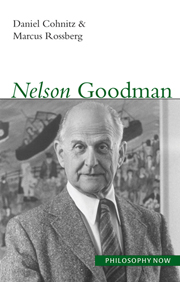Book contents
- Frontmatter
- Contents
- Acknowledgements
- Abbreviations
- 1 The worldmaker's universe
- 2 If this were an emerald it would be grue: problems and riddles of induction
- 3 The big picture
- 4 Particulars and parts
- 5 From Vienna Station to Boston Terminus
- 6 Follow the sign
- 7 Diagnosing art
- 8 Starmaking
- 9 Never mind mind, essence is not essential, and matter does not matter
- List of symbols
- Glossary of technical terms
- Further reading
- Notes
- Bibliography
- Index
5 - From Vienna Station to Boston Terminus
- Frontmatter
- Contents
- Acknowledgements
- Abbreviations
- 1 The worldmaker's universe
- 2 If this were an emerald it would be grue: problems and riddles of induction
- 3 The big picture
- 4 Particulars and parts
- 5 From Vienna Station to Boston Terminus
- 6 Follow the sign
- 7 Diagnosing art
- 8 Starmaking
- 9 Never mind mind, essence is not essential, and matter does not matter
- List of symbols
- Glossary of technical terms
- Further reading
- Notes
- Bibliography
- Index
Summary
Now that we have introduced some of the formal machinery that Goodman developed to approach philosophical problems, we are almost ready to understand his chief work. A Study of Qualities, which was first published in revised form as The Structure of Appearance, is certainly the most difficult piece Goodman ever wrote. It is full of technical subtleties and philosophically relevant observations. To understand its significance, however, we first have to look back at the philosophical context in which it was developed. We have emphasized in the previous chapters that Goodman's work is best understood as situated within a certain branch of analytic philosophy, departing from Frege's conception of ideal-language philosophy. Goodman's 1941 dissertation A Study of Qualities is in large part a thorough analysis and further elaboration of the work of Carnap, his most famous predecessor in this tradition. Therefore we shall first characterize Carnap's project in the Aufbau ([1928] 1961). Although Goodman's work is usually classified as being an anti-foundationalist version of Carnap's project, Carnap and Goodman in fact agreed on many more issues than is usually recognized. In fact, the main characteristics of Carnap's philosophy of the 1930s also characterize Goodman's philosophy:
• the methodological outlook of constructionalism;
• an anti-foundationalist epistemology;
• the emphasis on multiple systems and starting-points adequate to their respective purposes (i.e. methodological and ontological pluralism);
• the view that what are often taken as “ultimate” metaphysical questions are pointless except when relativized to a system (i.e. metaphysical and ontological relativism).
- Type
- Chapter
- Information
- Nelson Goodman , pp. 99 - 139Publisher: Acumen PublishingPrint publication year: 2006



